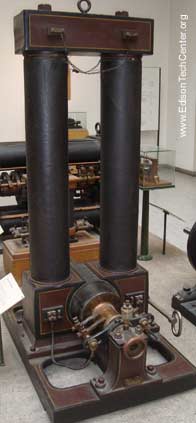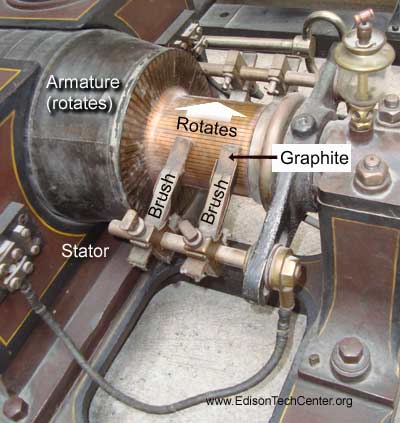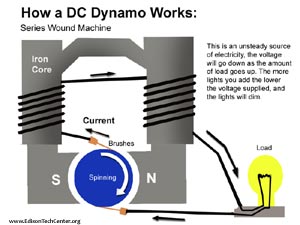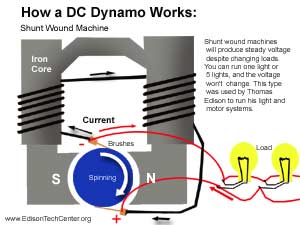Generators & Dynamos
Development and History of the component that made electricity first commercially feasible
Dynamos and Generators convert mechanical rotation into electric power.
Dynamo - a device that makes direct current electric power using electromagnetism. It is also known as a generator, however the term generator normally refers to an "alternator" which creates alternating current power.
Generator
- normally this term is used to describe an alternator which
creates AC power using electromagnetism.
Generators, Dynamos, and Batteries are the three tools necessary to create/store substantial amounts of electricity for human use. Batteries may have been discovered as early as 248 BC. They simply use chemical reaction to make and store electricity. Scientists experimented with the battery to invent the early incandescent lamp, electric motors and trains, and scientific tests. However batteries were not reliable or cost effective for any regular electrical use, it was the dynamo that radically changed electricity from a curiosity into a profitable, reliable technology.
1.
How it Works
2. Brief History of Dynamos and Generators
3. Videos of generators
1.) How it Works:
Basic:
First you need a mechanical power source like a turbine(powered by water falling), wind turbine, gas turbine or steam turbine. A shaft from one of these devices is connected to a generator to make power.

Dynamos and generators work using the wild complex phenomena of electromagnetism. Understanding the behavior of electromagnetism, its fields and its effects is a large subject of study. There is a reason why it took 60 years AFTER Volta's first battery to get a good powerful dynamo working. We will keep things simple to help introduce you to the interesting subject of power generation.
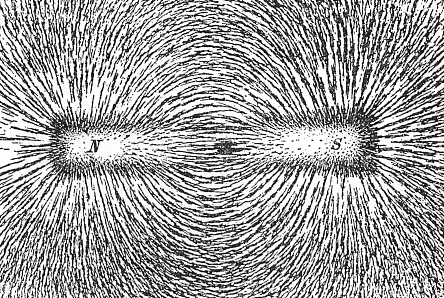
In the most basic sense a generator/dynamo is one magnet rotating while inside the influence of another magnet's magnetic field. You cannot see a magnetic field, but it is often illustrated using lines of flux. In the illustration above lines of magnetic flux would follow the lines created by the iron filings.
The generator/dynamo is made up of stationary magnets (stator) which create a powerful magnetic field, and a rotating magnet (rotor) which distorts and cuts through the magnetic lines of flux of the stator. When the rotor cuts through lines of magnetic flux it makes electricity.
But why?
Due to Faraday's Law of Induction if you take a wire and move it back and forth in a magnetic field, the field pushes on electrons in the metal. Copper has 27 electrons, the last two in the orbit are easily pushed on to the next atom. This movement of electrons is electrical flow.
See the video below showing how current is induced in a wire:
If you take a lot of wire such as in a coil and move it in the field, you create a more powerful "flow" of electrons. The strength of your generator depends on:
"l"-Length of the conductor in the magnetic field
"v"-Velocity of the conductor (speed of the rotor)
"B"-Strength of the electromagnetic fieldYou can do calculations using this formula: e = B x l x v
See the video to see all of this demonstrated:
About the magnets:
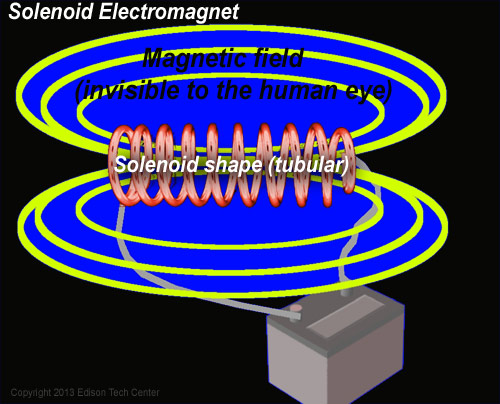
Above: a simple electromagnet referred to as a solenoid. The term "solenoid" actually describes the tubular shape created by the coiled wire.
The magnets are usually not made of natural magnetite or a permanent magnet (unless it is a small generator), but they are copper or aluminum wire coiled around an iron core. Each coil must be energized with some power to make it into a magnet. This coil around iron is called a solenoid. Solenoids are used instead of natural magnetite because the solenoid is MUCH more powerful. A small solenoid can create a very strong magnetic field.
Above: The coils of wire in the generators must be insulated. Generator failure is caused by temperatures rising too high which results in a breakdown of insulation and a short between to parallel wires. Learn more about wires >
|
Also see our page on Induction.
The Dynamo
Dynamo is an older term used to describe a generator that makes direct current power. DC power sends electrons in only one direction. The problem with a simple generator is that when the rotor rotates it eventually turns completely around, reversing the current. Early inventors didn't know what to do with this alternating current, alternating current is more complex to control and design motors and lights for. Early inventors had to figure a way to only capture the positive energy of the generator, so they invented a commutator. The commutator is a switch that allows current to only flow in one direction.
See the video below to see how the commutator works:
The Dynamo consists of 3 major components: the stator, the armature, and the commutator.
|
|
|
Self excitation:
Since the magnets in an dynamo are solenoids, they must be powered to work. So in addition to brushes which tap power to go out to the main circuit, there is another set of brushes to take power from from the armature to power the stator's magnets. That's fine if the dynamo is running, but how do you start a dynamo if you have no power to start?
Sometimes the armature retains some magnetism in the iron core, and and when it begins to turn it makes a small amount of power, enough to excite the solenoids in the stator. Voltage then begins to rise until the dynamo is at full power.
If there is no magnetism left in the armature's iron, than often a battery is used to excite the solenoids in the dynamo to get it started. This is called "field flashing".
Below in the discussion of wiring the dynamo you will notice how power is routed through the solenoids differently.
There are two ways of
wiring a dynamo: series
wound and shunt
wound. See the diagrams to learn the difference.
Below, video of a small simple dynamo similar to the diagrams above (built in the 1890s):
The Generator
The generator differs from the dynamo in that it produces AC power. Electrons flow in in both directions in AC power. It wasn't until the 1890s that engineers had figured out how to design powerful motors, transformers and other devices which could use AC power in a way that could compete with DC power.
While the alternator uses commutators, the generator uses a slip ring with brushes to tap the power off of the rotor. Attached to the slip ring are graphite or carbon "brushes" which are spring loaded to push the brush onto the ring. This keeps power consistently flowing. Brushes get worn down over time and need to be replaced.
Below, video of slip rings and brushes, many examples from old to new:
Since the time of Gramme in the 1860s it was figured out that the best way to build a dynamo/generator was to arrange magnetic coils around a wide circle, with a wide spinning armature. This looks different than the simple small dynamo examples you see used in teaching how the devices work.
In the photo below you will see clearly one coil on the armature (the rest were removed for servicing) and other coils built into the stator.
From the 1890s until today 3 phase AC power has been the standard form of power. Three phases is made through the design of the generator.
To make a three phase generator you have to place a certain number of magnets on your stator and armature, all with proper spacing. Electromagnetism is as complex as dealing with waves and water, so you need to know how to control the field through your design. Problems include having your magnet unevenly attracted to the iron core, improper calculations of the distortion of the magnetic field (the faster it spins, the more the field is distorted), spurious resistance in the armature coils, and a myriad of other potential problems.
Why 3 phase? if you want to know more about phases and why we use 3 phase, see our video with power transmission pioneer Lionel Barthold.
2.) A Brief History of Dynamos and Generators:
The generator evolved from work by Michael Faraday and Joseph Henry in the 1820s. Once these two inventors discovered and documented the phenomena of electromagnetic induction, it lead to experimentation by others in both Europe and North America.
1832 -
Hippolyte Pixii (France) built the first dynamo using a commutator,
his model created pulses of electricity separated by no current. He
also by accident created the first alternator. He did not know what
to do with the changing current, he concentrated on trying to eliminate
the alternating current to get DC power, this led him to create the
commutator.
1830s-1860s - The battery is still the most powerful way to supply
electricity for the various experimentation going on in that period.
Electricity was still not commercially viable. A battery powered electric
train from Washington DC to Baltimore failed, proving a gross embarrassment
to the new field of electricity. After millions of dollars wasted steam
still proved to be a better power source. Electricity still needed to
prove to be reliable and commercially viable.
1860 - Antonio Pacinotti- Created a dynamo that provided continuous
DC power
1867 - Werner Von Siemens and Charles Wheatstone create a more
powerful, more useful dynamo which used a self powered electromagnet
in the stator instead of the weak permanent magnet.
1871 - Zenobe Gramme sparked the
commercial revolution of electricity. He filled the magnetic field with
an iron core which made a better path for magnetic flux. This increased
the power of the dynamo to the point were it was usable for many commercial
applications.
1870s - There was an explosion of new designs in dynamos, designs
ranged a wild assortment, only a few stood out as being superior in
efficiency.
1876 - Charles F. Brush
(Ohio) developed the most efficient and reliable dynamo design ever
to that point. His inventions was sold through the Telegraph Supply
Company.
1877 - The Franklin
Institute (Philadelphia) conducts test on dynamos from around the world.
Publicity from this event spurs development by others like Elihu
Thomson, Lord Kelvin, and Thomas
Edison.
|
Above: Edison's Long Legged Mary, a commercially successful dynamo for his DC systems 1884 |
|
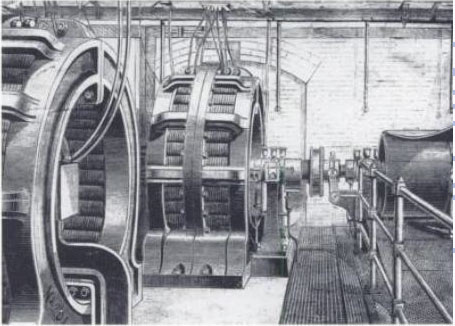
Above: Siemens AC generators used in London in 1885, in the US Edison was reluctant to jump into the AC power field while in Europe the technology was developing rapidly.
1886-1891 - Polyphase AC generators are developed by C.S. Bradly (US), August Haselwander (Germany), Mikhail Dolivo-Dobrovsky (Germany/Russia), Galileo Ferraris (Italy), and others. AC systems which include better control and powerful electric motors allow AC to compete.
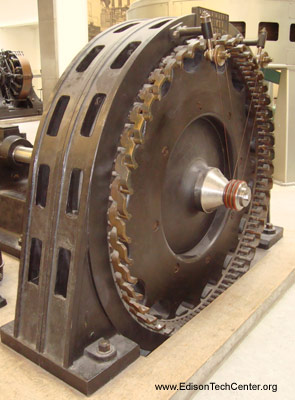 |
|
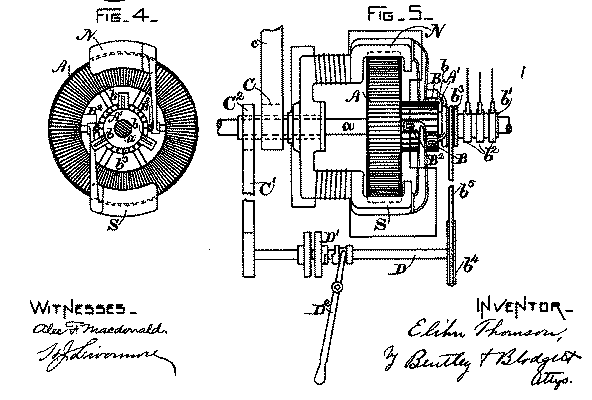
Above: 1894 Elihu Thomson developed many AC generators for General Electric

A later Westinghouse 2000 kW 270 Volt generator from after 1900
3. Videos
Mechanicville Generators with history explained (1897), designed by AC mastermind Charles P. Steinmetz
Westinghouse Generator being constructed and tested (1905), designed by Oliver Shallenberger, Tesla and others at Westinghouse.
1895 Early powerful generators used at Folsom, CA (designed by Elihu Thompson, Dr. Louis Bell, and others at GE)
1891 Generator produced by Oerlikon for the International Electro-technical Exhibition (designed by Dobrovolsky in Germany)
Related Topics:
|
Diesel Electric Locomotives |
Transformers |
AC Power History |
Power Transmission |
Electric Motors |
Wires and Cables |



